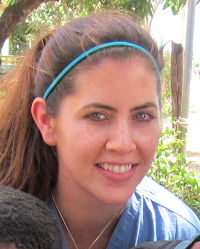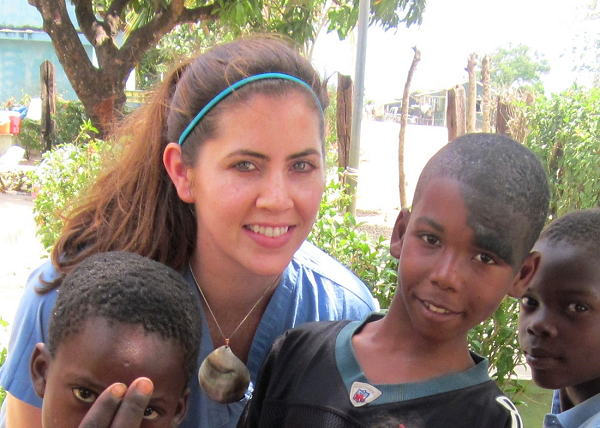At any given time of year, there are scores of students, faculty and researchers off campus—some way, way off campus—in the Dominican Republic, Peru, Ghana, Liberia—providing aid, serving fellowships and gaining experience they can apply to their work, and their patients, here at home. This special edition of the Daily Voice highlights a first-person narrative from a recent international experience.
| Kelley Wittbold, SOM ’14, writes about her experiences during this year’s spring break medical mission trip to the Dominican Republic. Read about this two-week interprofessional educational experience , which started with eight students just six years ago, but this year included seven nursing students, 33 medical students and three MD/PhD students as well as 15 preceptors. Wittbold participated on the second week of the trip. |  |
In one week, our team of roughly 40 doctors, nurses and medical students were able to see and treat over 1,000 underserved patients that live on the sugar cane plantations outside the city of La Romana, Dominican Republic.
The days were full of long, hard work and gritty sweat. There were children with colds and fevers and infections and parasites, the amputees that needed wound debridement, the women with reproductive organ complications needing pap smears on our makeshift “pap bus” (the only available mode for ensuring privacy for these patients), and in more severe cases, taken for surgery at the city hospital. There were brawny men with aches and pains all over from repeated swinging of their machetes to cut the sugar cane in the fields. There was the middle-aged woman with an oversized heart, both literally on x-ray and figuratively on case interview. There were countless tooth extractions. There were band aids for the children who didn’t have wounds but just needed reassurance that they were in good health and everything would be OK. There were 8-year-old girls taking care of infants because their parents were either working or had passed away.
There were 13-year-olds told of their first pregnancy; elation ensued thereafter for some, worry and concern pervaded for others, while indifference and matter-of-fact acceptance was the feeling expressed from most. There were a select few young men who taught themselves broken English through listening to American music on their battery-powered radios, and whose eyes lit up with so much hope when they talked of coming to the United States for an education. There was a 10-year-old who asked me how she could become a doctor in the United States. At one of the barrios (poor city neighborhood) several adolescent girls asked me “Tienes un esposo y hijos?” (Do you have a husband and children?). When I told them that “Yo quiero casarse y tener hijos cuando yo tengo treinta anos” (I want to get married and have children when I am in my thirties), their mouths dropped in shock. One of the young girls then asked, “Como es posible?” (How is that possible?).
There were layers upon layers to barriers of communication, through which our invaluable interpreters guided us to understanding each patient’s medical needs. The interpreters have dual responsibilities as they also ensure the continuity of care for these populations. The interpreters, under the guidance of the Good Samaritan Hospital in La Romana, coordinate other medical teams that travel to the Dominican to follow up with the patients of the bateys.
There were incredible moments of learning from both older medical students and our overseeing physicians and nurses. I’ve never learned pharmacy so fast and so in depth than I did last week. The evolution in flow from day one case history reports to day five proved to be light years apart for each student, including myself. The transition from overly thorough, every-test-in-the-book care that we are used to in the U.S. was quickly carved down to the crucial emergency-medicine, focused case history approach as the clinics filled up with crowds of sick and ailing patients.
I also had the privilege to work in the ultimate team environment, which naturally fell into place because everyone who was there was there for the same reason—because we wanted to help. With a common goal and unusual adaptability, the strategies fell into place, and things got done.
What is most remarkable about the Dominican natives and Haitian immigrants we treated is both their resilience and the vibrance of their communities. Despite having close to nothing and living not unlike slaves, they have a sense of community and caring for one another that in many places of the United States would be hard to come across, regardless of blood relation or assigned responsibility.
We did good work, but there is much more work to be done in the Dominican Republic. It does not feel like it is 2011 there. On the bateys, water is still pumped by hand from the ground and there is no electricity. Women have minimal options for family planning and therefore little control over their fate and reproductive choices.
A personal goal of mine that has resulted from this trip is to pursue further information and initiative on acquiring donations or subsidized Mirena Intrauterine Devices from Bayer Health care—an implantable birth control option that allows women to control their reproductive fate for up to five years. I don’t know how I will do this yet, but the wheels are spinning and as I have learned in the past, where there is an initiative, there can be success. With women able to control their choice to have children (or to have 1 or 2 children rather than 13), they will be better equipped to handle other choices in their life—like whether to attend school beyond the 7th grade level, whether to learn English in the city and get a better paying job to support themselves, or to be empowered to make decisions that further their own well-being.
Our medical efforts in the Dominican do make a difference in the lives of the people we treat, both in small and big ways, but the overall access to quality health care for these people is a systems engineering challenge. It requires doctors, politicians, economists, engineers and progressive thinkers. It requires motivation and an evolution of the cultural and socioeconomic infrastructure. The resolutions for the big picture require more than what one person can do alone, but it starts somewhere. I am grateful for all of your contributions and support that has allowed me to contribute and be part of that picture.
One of the hardest parts about our work in the Dominican was meeting patients who had health problems that could very easily be treated in the U.S., but for which there was no accessible treatment in the Third World. I encourage everyone reading this to take a moment to reflect upon how fortunate we are to be American citizens (or, for my international friends, living in America) with access to American health care. I was aware of this fact before, but my experience over the past week has ground that lesson to heart.
Be kind to yourself, your health, your neighbors and your family.
Thank you again for all of your support.
Peace, love and good health.
 This 8 year-old-boy developed an expanding hemangioma (an abnormal network of capillaries and blood vessels) on his scalp and forehead. He explained to me that he got it because his mother slept on her side with her hands under her head while she was pregnant with him (this was a great story, but not actually the natural history of the disease). Before leaving, I told him "Yo creo que ya eres muy guapo and fuerte" (I still think you are very strong and handsome). He shook his head no, because all of the other children in the batey had taken his self esteem. Though it is benign, the aesthetic manifestations can only be resolved with a procedure that is normally done with multiple laser treatments by specialty dermatologists, neither of which are available in the Dominican Republic. |